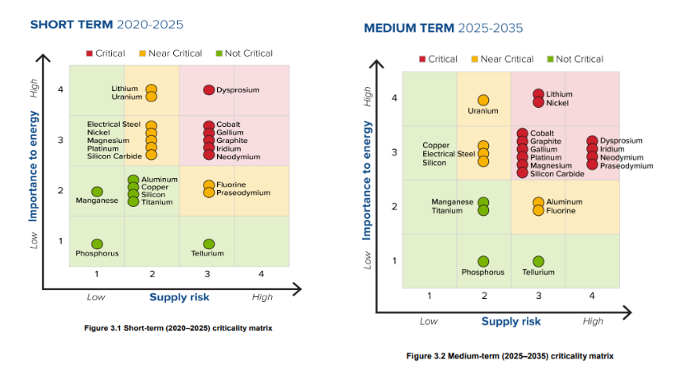The U.S. Department of Energy (DOE) has issued a Request for Information (RFI) in order to gather public input on the draft Critical Materials Assessment (full report available here).
The RFI, which is being issued by the Office of Energy Efficiency and Renewable Energy (EERE)’s Advanced Materials and Manufacturing Technologies Office (AMMTO), aims to enhance the DOE Critical Materials Assessment before it is finalised.
The DOE is actively seeking input from the public on these areas of interest to ensure that the Critical Materials Assessment is comprehensive and accurate.
This Critical Materials Assessment outlines the governments critical material strategies.
These strategies prioritise R&D to meet the nation’s energy needs whilst reducing reliance on materials with high supply risk. The supply risk is assessed by comparing anticipated demand with existing production capacity, considering factors such as social, political, and market disruptions, to determine the potential shortfall in supply.
Instead of making predictions about the future, the objective is to gain insights into potential roadblocks that may hinder the deployment of energy resources in the short term (0-5 years) and medium term (5-10 years) and utilise this understanding to guide R&D investments and policy engagement.
These reports cover technologies such as carbon capture, electric grid (including transformers and high-voltage direct current transmission), energy storage, fuel cells and electrolysers, hydropower including pumped storage hydropower, rare earth magnets, nuclear energy, platinum group metal catalysts, semiconductors, solar photovoltaics, and wind energy.
The final candidate list has 37 materials, including: aluminium (Al), boron (B), cobalt (Co), copper (Cu), dysprosium (Dy), electrical steel, fluorine (F), gallium (Ga), gallium nitride (GaN), germanium (Ge), indium (In), iridium (Ir), iron (Fe), lanthanum (La), lithium (Li), magnesium (Mg), manganese (Mn), mixed rare earth oxide (MREO), natural graphite, neodymium (Nd), nickel (Ni), palladium (Pd), phosphorous (P), praseodymium (Pr), platinum (Pt), rhodium (Rh), silicon (Si), silicon carbide (SiC), sodium (Na), strontium (Sr), sulfur (S), tellurium (Te), titanium (Ti), uranium (U), vanadium (V), yttrium (Y), zinc (Zn), and zirconium (Zr).


Market developments since the 2019 report
Since the last DOE CMS report in 2019, global material supply chains have been significantly impacted by various events.
- The Covid-19 pandemic has caused labour and material shortages, reduced capacity, and delayed capacity development for multiple energy products.
- Additionally, Russia’s invasion of Ukraine has limited energy and material supply to the US and European countries, leading to increased pressure on obtaining supply from other Asian countries and higher prices.
Consequently, the pressure to acquire additional supply from Asian countries has intensified, resulting in higher prices.
The International Energy Agency (IEA) reported that increased fuel prices contributed to 90% of the global rise in average electricity generation costs. Despite the pandemic, certain clean technologies like EVs remained unaffected. Russia’s invasion of Ukraine increased the demand for oil and gas, prompting governments to revise their energy security plans and medium-term deployment of clean energy towards zero carbon emissions by 2050.
Screening of Materials and Technologies
The report outlines the screening methodology, to provide a simple and replicable method for categorising materials into two groups:
- Key materials – those that have particular relevance to clean energy and decarbonisation technologies in the near to medium future.
- Lower-risk materials – those that are anticipated to be less important to clean energy and decarbonisation technologies in the short and medium term.
The screening method employs a weighted scoring system that incorporates three factors. These factors are designed to assess:
- The significance of the broader technology class to the energy system
- The relative importance of the specific sub-technology or component within its class
- The significance of the particular material.
For instance, when scoring neodymium for its application in wind turbines, the importance of wind energy is initially evaluated, followed by the importance of turbines equipped with direct-drive generators, and finally, the anticipated increase in neodymium demand associated with the growth of this specific technology.

The above table demonstrates the assignment of thresholds to each metric, enabling the scoring of each material/technology pair as 1, 2, or 3 based on the metric values. Additionally, each metric was assigned a weight ranging from 2 to 4 out of a total of 9 points to highlight their relative importance. To calculate the total weighted score for each material/technology pair, the score for each metric was multiplied by its corresponding weight.
Screening Results
The following figure provides a summary of the screening scores obtained by the 37 candidate materials. Materials located to the left of iron in the figure meet the threshold to be classified as key materials, while the remaining materials are considered lower risk.

Criticality Assessment
The report outlines the criticality assessment methodology, in which the criticality results for the short and medium term are presented. The assessments focus on two aspects:
- The significance to energy
- The risk of supply
These two dimensions are rated on a scale from one to four and presented on a matrix to illustrate the relative criticality of individual minerals. According to this scheme, the upper right-hand corner of the matrix represents the highest criticality.
This evaluation specifically addresses concerns related to energy technologies. Firstly, the importance of a material to the energy sector replaces the assessment of “impact of supply restriction.” Secondly, five distinct factors are introduced to assess the “supply risk” of a material. Lastly, the assessments take a forward-looking approach by considering demand scenarios and analysing the supply and demand dynamics in the short and medium terms, which can inform different policy response options.
Overall, results are as follows:

The overall Critical Materials Assessment provide an understanding of the vulnerability of relevant supply chains, by identifying the critical materials attributable to the energy movement via multiple assessment methodologies.
The Critical Materials Assessment has influenced DOE’s research priorities in the past and requires regular updates due to the changing nature of criticality. The assessment is revised every three years to reflect current data and market conditions.







